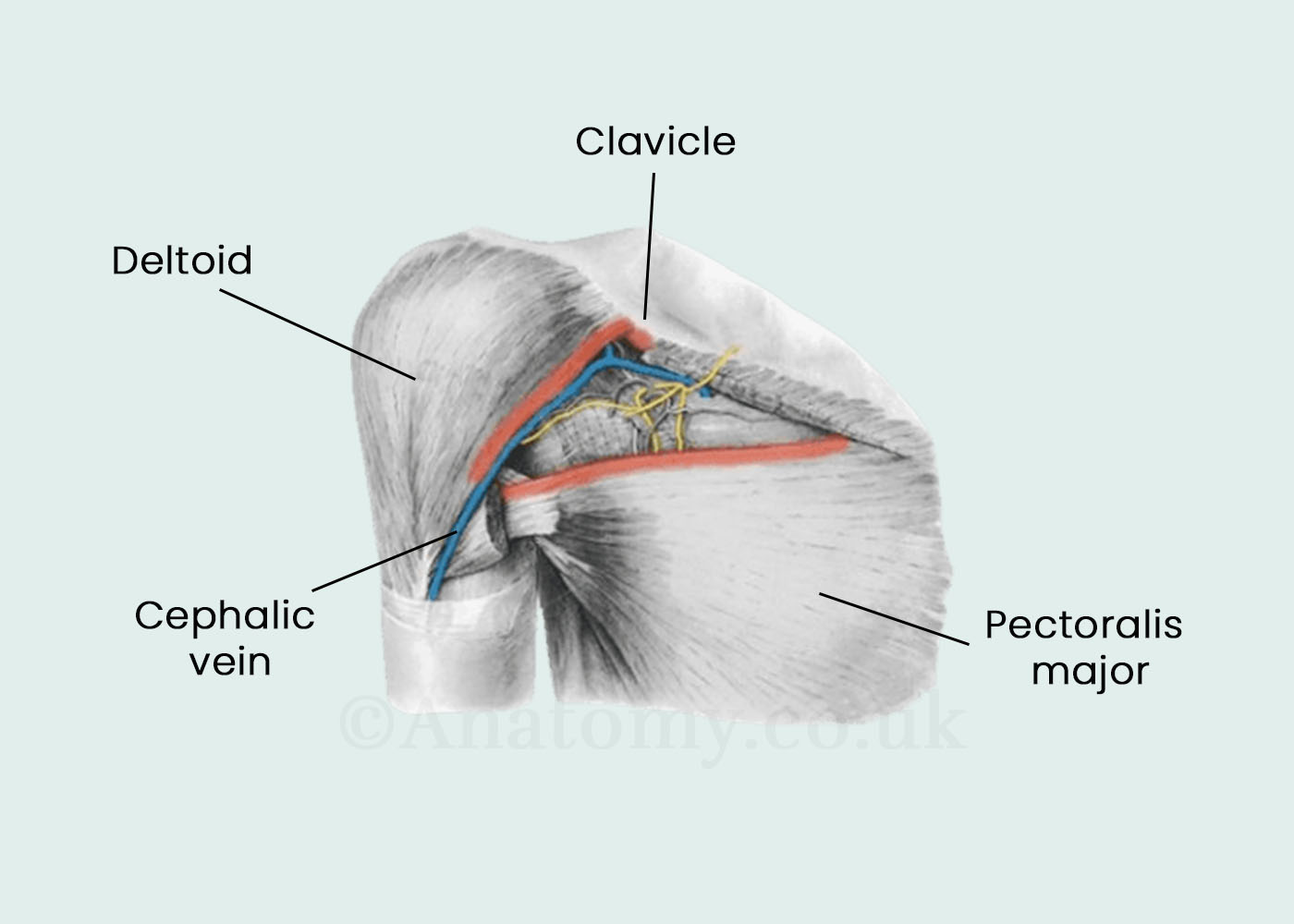The clavipectoral triangle is a triangular region located in the upper chest and shoulder area. It is bounded by the clavicle (collarbone) superiorly, the pectoralis minor muscle medially, and the coracoid process of the scapula laterally. The base of the triangle is located at the clavicle, and the apex points inferiorly towards the axilla (armpit).
Structure
Borders
As mentioned above, the clavipectoral triangle is bounded by the clavicle, pectoralis minor muscle, and coracoid process.
Contents
The contents of the clavipectoral triangle include several important structures, including:
- Cephalic vein: This vein is a large vein located in the upper arm and chest region. It begins at the hand and passes upwards through the clavipectoral triangle, where it can be easily accessed for venipuncture (blood draw).
- Lateral pectoral nerve: This nerve is a branch of the brachial plexus, a network of nerves that supplies the upper limb. It passes through the clavipectoral triangle and supplies innervation to the pectoralis major muscle.
- Thoracoacromial artery: This is a branch of the axillary artery, which is a major artery in the upper limb. It passes through the clavipectoral triangle and supplies blood to the chest and shoulder region.
Diagram

Picture 1: Diagram of Clavipectoral triangle
Location
The clavipectoral triangle is located in the upper chest and shoulder region. It is bounded by the clavicle superiorly, the pectoralis minor muscle medially, and the coracoid process of the scapula laterally. The base of the triangle is located at the clavicle, and the apex points inferiorly towards the axilla (armpit).
To locate the clavipectoral triangle, you can start by finding the clavicle, which is a long, slender bone located at the top of the chest. It runs horizontally across the top of the chest, and can be easily palpated (felt) just under the skin. From the clavicle, you can then follow the line of the pectoralis minor muscle down towards the axilla. The coracoid process is a bony protuberance located on the scapula (shoulder blade) that can be felt just above the pectoralis minor muscle. The area bounded by these three structures is the clavipectoral triangle.
Function
Functions of the Clavipectoral Triangle include:
Venous access
The cephalic vein, which passes through the clavipectoral triangle, is a large vein that can be easily accessed for venipuncture (blood draw). This makes it an important site for obtaining blood samples for laboratory testing or for administering medications or fluids intravenously.
Nerve supply
The lateral pectoral nerve, which passes through the clavipectoral triangle, is a branch of the brachial plexus and supplies innervation to the pectoralis major muscle. This muscle is important for movement of the upper limb, and its innervation is essential for normal function.
Blood supply
The thoracoacromial artery, which passes through the clavipectoral triangle, is a branch of the axillary artery and supplies blood to the chest and shoulder region. This artery may be used for arterial blood gas analysis or for placement of an arterial line, which is a device used to continuously monitor blood pressure and oxygenation in critically ill patients.
Lymph node swelling
The clavipectoral triangle is a common site for lymph node swelling in the case of lymphadenopathy (enlargement of the lymph nodes). This may be due to infection, inflammation, or other underlying medical conditions, and it may be accompanied by other signs and symptoms such as fever, fatigue, and weight loss.
Clinical significance
- Venous access: The cephalic vein, which passes through the clavipectoral triangle, is a large vein that can be easily accessed for venipuncture (blood draw). This makes it an important site for obtaining blood samples for laboratory testing or for administering medications or fluids intravenously.
- Nerve supply: The lateral pectoral nerve, which passes through the clavipectoral triangle, is a branch of the brachial plexus and supplies innervation to the pectoralis major muscle. This muscle is important for movement of the upper limb, and its innervation is essential for normal function. Damage to this nerve can result in weakness or paralysis of the pectoralis muscle, which can affect the ability to lift or move the arm.
- Blood supply: The thoracoacromial artery, which passes through the clavipectoral triangle, is a branch of the axillary artery and supplies blood to the chest and shoulder region. This artery may be used for arterial blood gas analysis or for placement of an arterial line, which is a device used to continuously monitor blood pressure and oxygenation in critically ill patients.
- Lymph node swelling: The clavipectoral triangle is a common site for lymph node swelling in the case of lymphadenopathy (enlargement of the lymph nodes). This may be due to infection, inflammation, or other underlying medical conditions, and it may be accompanied by other signs and symptoms such as fever, fatigue, and weight loss. The presence of enlarged lymph nodes in this region may be a sign of a more serious underlying condition, and further evaluation and treatment may be necessary.
- Physical examination: The clavipectoral triangle is an important area for medical professionals to assess during a physical examination. Palpation of this region can help to identify any abnormalities or swelling, such as lymphadenopathy or a mass. In addition, the presence or absence of certain structures within the clavipectoral triangle can provide important information about the overall health and function of the upper limb.
